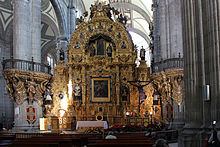Mexico City Cathedral
The Cathedral of Mexico City ( Catedral Metropolitana de la Asunción de María de la Ciudad de México ) is the largest and oldest cathedral on the American continent and the seat of the Catholic Archbishop of Mexico . It stands on the north side of the Plaza de la Constitución in Mexico City . The cathedral bears the patronage of the Assumption of Mary .
history
The church was built from 1573 in the southwest of the Aztec temple district according to plans by the Spanish architect Claudio de Arciniega, whose plans were based on the Gothic cathedrals of Spain . Other important architects were Juan Gómez de Mora and Alonso Pérez de Castaneda. The foundation stone for the construction of the cathedral was laid in 1524 by the leader of the Spanish colonization, Hernán Cortés .
Construction work was interrupted in 1629 due to flooding. The interior was completed by 1667. The church was consecrated that same year. The two bell towers designed by the architect José Damián Ortiz de Castro, which now have 25 bells, were completed in 1793. The building was completed in 1813 with a dome and facade designed by the architect Manuel Tolsá .
In 1967 parts of the interior were destroyed in a fire caused by a short circuit. 1979 began the reconstruction of the choir area. During the renovation work, 51 paintings were found behind the Altar of Forgiveness, including works by Juan and Nicolas Rodriguez Juarez, Miguel Cabrera and José de Ibarra. The burial place of the first governor of Veracruz, Miguel Barrigan, was rediscovered at the choir arch.
The church was statically threatened by subsidence beneath the city and was stabilized in the 1990s with the help of a tunnel network under the cathedral. In September 2019, abortion advocates carried out an arson attack on the cathedral during a demonstration, which, thanks to the rapid intervention of the fire brigade, remained without major damage.
Architecture and equipment
The building with a cruciform floor plan is oriented in a north-south direction. The main facade is on the south side. The interior dimensions of the cathedral are 118 m long, 54 m wide and 55 m high. The interior consists of five naves with fourteen chapels, a sacristy, a chapter house, the choir and a crypt. Due to its long construction period, it received influences from the Renaissance , Baroque and Classicism .
The main altars are named: Altar of Forgiveness, Altar of Kings, Altar of the Risen Jesus and Altar of the Virgin of Zapopan. The richly carved Churrigueresque altar of the Kings Altar de los Reyes from the period from 1718 to 1739 is particularly worth seeing in the main apse . The choir stalls from 1696 are made of cedar wood.
Chapels
- Capilla de Nuestra Senora de las Angustias de Granada
- Capilla de San Isidro
- Capilla de la Inmaculada Concepción
- Capilla de Nuestra Senora de Guadalupe
- Capilla de Nuestra Señora de La Antigua
- Capilla de San Pedro
- Capilla del Santo Cristo y de las Reliquias
- Capilla de los Ángeles
- Capilla de San Cosme y San Damián
- Capilla de San José
- Capilla de Nuestra Señora de la Soledad
- Capilla de San Eligio
- Capilla de Nuestra Senora de los Dolores
- Capilla del Senor del Buen Despacho
- Capilla de San Felipe de Jesús
Organs
There are two organs in the cathedral . The organ on the Epistle side dates from 1695. The instrument has 64 stops on three manual works (the two “caderetas” can be played from one manual) and a pedal. 26 registers are full registers, 38 registers are either bass or treble registers.
|
|
|
|
|||||||||||||||||||||||||||||||||||||||||||||||||||||||||||||||||||||||||||||||||||||||||||||||||||||||||||||||||||||||||||||||||||||||||
The organ on the Gospel side dates from 1735. The instrument consists of two positive works by Cadereta , which can be played from the 1st manual, the main and pedal parts, and an additional solo work for the right hand, that of the 1st manual from is playable.
|
|
|
|
|
|||||||||||||||||||||||||||||||||||||||||||||||||||||||||||||||||||||||||||||||||||||||||||||||||||||||||||||||||||||||||||||||||||||||||||||||||||||||||
Peal
The two bell towers house a total of 25 bells. The largest, named Santa Maria de Guadalupe , weighs 13,000 kilos. Another is called Doña Maria .
Surroundings
The facade of the Sangrario Metropolitano annex is made of Tezontle , a reddish volcanic stone. Today's parish church was originally built as a sacraments house. The consecration took place in 1768. The main altar inside was created in 1829 by Pedro Patiño Ixtolinque.
Individual evidence
- ↑ Manuel Tolsá. Retrieved June 19, 2019 .
- ↑ A cathedral sinks into the ground. Retrieved June 19, 2019 .
- ^ Abortion rights activists try to burn Mexico City cathedral. The Catholic Herald, September 29, 2019, accessed September 30, 2019 .
- ↑ Mexico City's Metropolitan Cathedral: The Complete Guide. Retrieved June 19, 2019 .
- ↑ Information on the cathedral organs ; see also the short report on the organs (Spanish; PDF; 7.9 MB)
- ↑ History Of The Metropolitan Cathedral Of Mexico City In 60 Seconds - 2019. Retrieved June 19, 2019 (German).
Web links
Coordinates: 19 ° 26 ′ 4.1 ″ N , 99 ° 7 ′ 59.2 ″ W.



